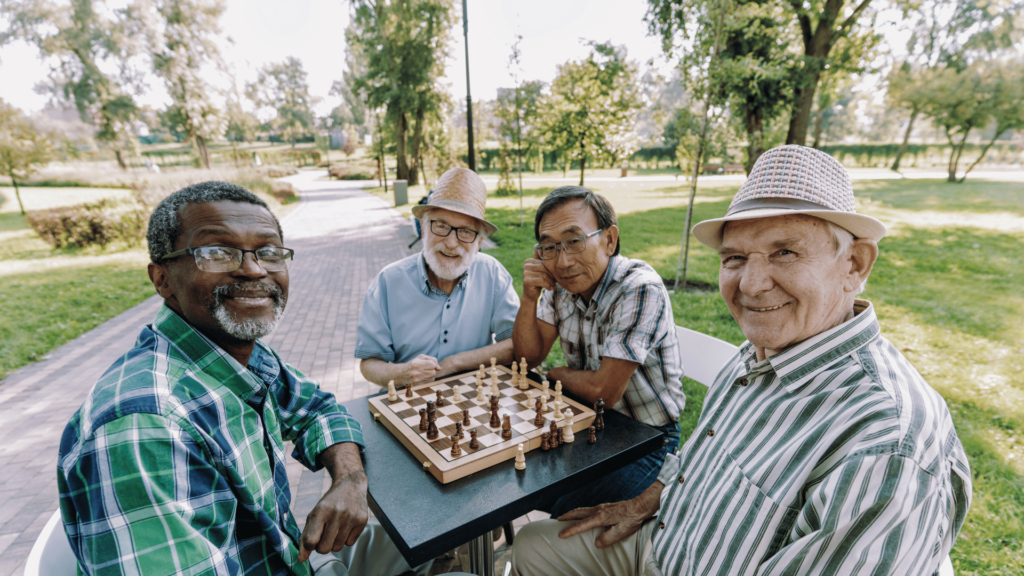Maintaining Mental Wellness
in Assisted Living
Moving into an assisted living community represents a significant life transition. While it offers valuable support and care, it’s natural for seniors to experience a range of emotions during this period. Maintaining mental wellness is crucial for a fulfilling and joyful experience in assisted living. This blog post explores practical strategies, activities, and resources to help seniors cultivate emotional resilience and thrive in their new environment.
Understanding the Importance of Mental Wellness in Assisted Living
Mental wellness is more than just the absence of mental illness. It encompasses emotional, psychological, and social well-being.
For seniors in assisted living, maintaining mental wellness can:
- Enhance Quality of Life: A positive mental state contributes to overall happiness and satisfaction.
- Reduce Loneliness and Isolation: Assisted living communities offer opportunities for social interaction, which is vital for mental health.
- Boost Cognitive Function: Engaging in mentally stimulating activities can help maintain cognitive abilities.
- Improve Physical Health: Mental and physical health are interconnected. Positive emotions can positively impact physical well-being.
- Promote Resilience: Developing coping mechanisms helps seniors navigate life’s challenges with greater ease.
Challenges to Mental Wellness in Assisted Living
Seniors may face unique challenges that affect their mental wellness, including:
- Adjustment to a New Environment: Moving from a familiar home to a new setting can be stressful.
- Loss of Independence: Some seniors may struggle with the perceived loss of independence.
- Health Concerns: Chronic illnesses and physical limitations can impact emotional well-being.
- Grief and Loss: Seniors may experience the loss of loved ones, leading to feelings of sadness and grief.
- Social Isolation: Despite being in a community, some seniors may struggle to connect with others.
Strategies for Promoting Mental Wellness
Here are practical strategies that seniors, families, and assisted living staff can implement to foster mental wellness:
- Fostering Social Connections:
- Group Activities: Encourage participation in group activities such as arts and crafts, music therapy, and games.
- Social Gatherings: Organize regular social events, including coffee mornings, movie nights, and holiday celebrations.
- Intergenerational Programs: Facilitate interactions with younger generations through volunteer programs or visits from schools.
- Peer Support Groups: Create support groups where residents can share experiences and offer emotional support.
- Utilize Common Areas: Encourage residents to spend time in common areas to interact with others.
- Engaging in Meaningful Activities:
- Hobbies and Interests: Support residents in pursuing their hobbies and interests, whether it’s gardening, painting, or reading.
- Volunteering: Encourage volunteer opportunities within the community or local organizations.
- Lifelong Learning: Offer educational programs, lectures, and workshops to stimulate the mind.
- Spiritual Practices: Provide opportunities for spiritual reflection and religious services.
- Pet Therapy: Introduce pet therapy programs, as interacting with animals can reduce stress and improve mood.
- Promoting Cognitive Stimulation:
- Puzzles and Games: Engage residents in activities like crossword puzzles, Sudoku, and board games.
- Memory Exercises: Implement memory exercises and cognitive training programs.
- Storytelling and Reminiscence: Encourage residents to share their life stories and memories.
- Reading and Writing: Promote reading groups and writing workshops.
- Technology Use: Introduce technology such as tablets and computers to facilitate communication and cognitive engagement.
- Providing Emotional Support:
- Counseling Services: Offer access to counseling and therapy services for residents who need additional support.
- Staff Training: Train staff to recognize signs of emotional distress and provide compassionate care.
- Family Involvement: Encourage family members to visit regularly and stay connected.
- Active Listening: Emphasize the importance of active listening and empathy in interactions with residents.
- Create a Supportive Environment: Foster a warm, welcoming, and non-judgmental atmosphere.
- Maintaining Physical Health:
- Exercise Programs: Offer tailored exercise programs to improve physical fitness and mood.
- Healthy Diet: Provide nutritious meals and snacks to support physical and mental health.
- Adequate Sleep: Ensure residents have comfortable sleeping environments and promote healthy sleep habits.
- Pain Management: Address chronic pain and physical discomfort promptly.
- Outdoor Activities: Encourage residents to spend time outdoors and enjoy nature.
- Utilizing Technology:
- Video Calls: Facilitate video calls with family and friends to maintain connections.
- Social Media: Help residents learn to use social media platforms to stay connected.
- Virtual Reality (VR): Explore VR experiences to provide immersive and stimulating activities.
- Online Games and Apps: Utilize apps and online games designed for cognitive stimulation and social interaction.
- Digital Photo Albums: Create digital photo albums to share and reminisce about cherished memories.
- Creating a Sense of Purpose:
- Resident Councils: Establish resident councils to give seniors a voice in community decisions.
- Mentoring Programs: Pair residents with younger individuals for mentoring opportunities.
- Community Projects: Involve residents in community service projects.
- Celebrating Achievements: Acknowledge and celebrate residents’ accomplishments and milestones.
- Personalized Care Plans: Tailor care plans to reflect individual interests and goals.

The Role of Assisted Living Staff and Families
Assisted living staff play a crucial role in promoting mental wellness. They should:
- Be trained in mental health awareness and support.
- Foster a positive and inclusive community environment.
- Communicate regularly with residents and their families.
- Advocate for residents’ needs and preferences.
- Monitor residents’ emotional well-being and intervene when necessary.
Families can also contribute by:
- Visiting regularly and staying connected.
- Communicating openly and honestly with their loved ones.
- Supporting their loved ones’ participation in activities.
- Advocating for their loved ones’ needs.
- Being a source of emotional support.
Resources and Support
- National Alliance on Mental Illness (NAMI): Provides support, education, and advocacy for individuals with mental illness and their families.
- The Gerontological Society of America (GSA): Offers resources and information on aging and mental health.
- Local Senior Centers: Offer social activities, support groups, and educational programs.
- Mental Health Professionals: Provide counseling, therapy, and psychiatric services.
Conclusion
Maintaining mental wellness in assisted living is an ongoing process that requires a holistic approach. By fostering social connections, engaging in meaningful activities, promoting cognitive stimulation, providing emotional support, and maintaining physical health, seniors can thrive in their golden years. Assisted living communities, staff, and families must work together to create a supportive and enriching environment that prioritizes mental wellness. Remember, emotional well-being is just as important as physical health, and with the right strategies and support, seniors can experience a fulfilling and joyful life in assisted living.
Latest Blogs
The Importance of Male Friendships in Senior Communities
Moving into an assisted living community represents a significant life transition. While…
Maintaining Mental Wellness in Assisted Living
Moving into an assisted living community represents a significant life transition. While…
Strategies for Supporting a Loved One with Dementia or Alzheimer’s
Dementia and Alzheimer's disease present unique challenges, not only for the individuals…



